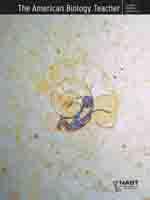Diffusion and osmosis are important biological concepts that students often struggle to understand. These are important concepts because they are the basis for many complex biological processes, such as photosynthesis and cellular respiration. We examine a wide variety of representations used by experienced teachers to teach diffusion and osmosis. To help teachers select appropriate representations for their students, we briefly describe each representation and discuss its pros and cons. After teachers select representations, we offer recommendations for sequencing them. We recommend beginning with macroscopic-level representations that easily allow students to visualize the phenomenon, then moving to microscopic-level representations (cell-level), and finally exploring the phenomenon at the molecular level using virtual representations.
How to translate text using browser tools
1 August 2012
Red Onions, Elodea, or Decalcified Chicken Eggs? Selecting & Sequencing Representations for Teaching Diffusion & Osmosis
Deanna Lankford,
Patricia Friedrichsen
ACCESS THE FULL ARTICLE
It is not available for individual sale.
This article is only available to subscribers.
It is not available for individual sale.
It is not available for individual sale.

The American Biology Teacher
Vol. 74 • No. 6
August 2012
Vol. 74 • No. 6
August 2012
diffusion
models
Osmosis
representations
sequencing




